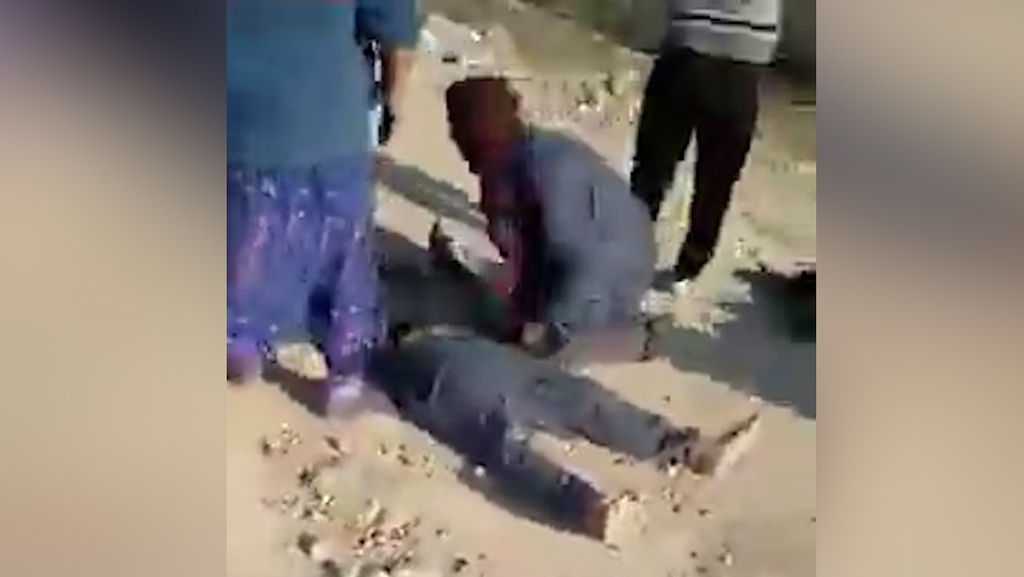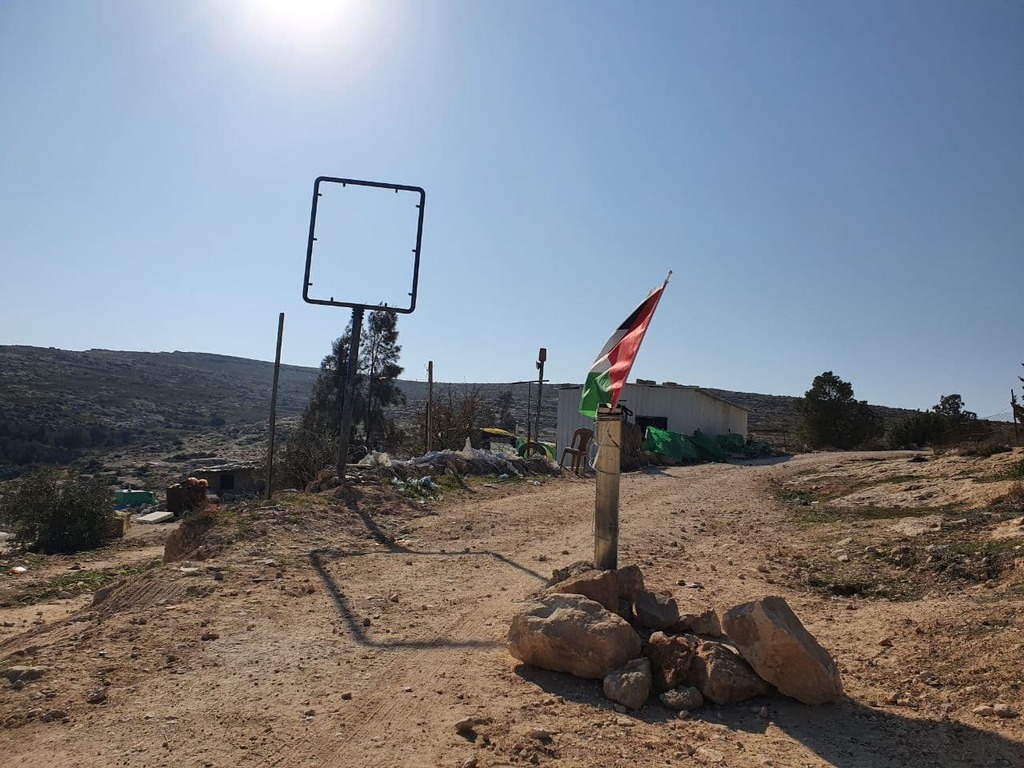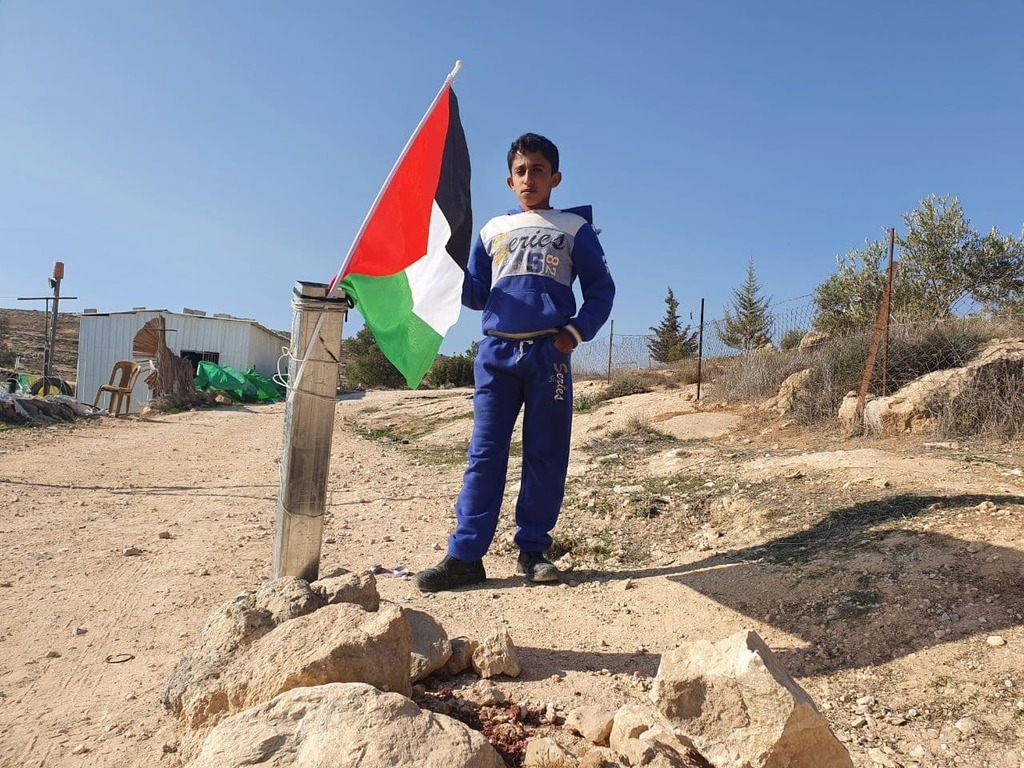The first shocking thing about watching the footage of in the Palestinian village of a-Rakeez in the South Hebron hills happens even before two shots are heard, when he is found lying on the ground, as his family members cry out for help.
The shock is due to the sight of Palestinians physically resisting the soldiers trying to confiscate their generator. Harun himself tries to salvage the generator with such determination that he loses his sandals.
3 View gallery


Harun Abu ‘Aram lies on the ground after he was shot by IDF troops demolishing his home
It is rare for Palestinians to resist a demolition or confiscation this way.
Documentation of the demolitions Israel carries out in the areas of the West Bank, where it forbids all Palestinian construction or development, is published in B’Tselem’s blog “Communities Facing Expulsion,” along with information about the exact equipment that the Civil Administration’s bulldozers destroyed and what exactly was confiscated.
Watching this footage reveals that most Palestinians are so intimidated that it does not occur to them to do more than argue, swear, or film the demolition that will leave them homeless and exposed to the scorching summer sun or winter storms.
Take for example a video from the demolition wave in December, where the Civil Administration’s contract workers can be seen dismantling a tin-roofed shack in the community of a-Zar’i (Za’atrah), which lies near the village of a-Za’ayem.
The cameraman, who happens to be the homeowner, does not intervene and only stands aside, narrating his anger to the video’s soundtrack. And here is another video, where a group of Bedouins from Ras ‘Ein al-‘Auja are seen sitting and watching as a Civil Administration bulldozer demolishes and confiscates their residential and agricultural shacks.
Two youths who argue with the soldiers are pushed backwards. Scroll further down and you will see another video from November, where a bulldozer demolishes Abu ‘Aram’s family home - the same Harun Abu ‘Aram who currently lies paralyzed from the neck down at al-Ahli Hospital in Hebron.
Family members stand near the condemned structure, as one woman films on her mobile phone. Two mothers sit and watch on plastic chairs with a young girl in tow.
Documentation from another demolition, this time a home that housed a family of 19 in the al-Khalediah area, depicts them protesting, setting tires on fire, and climbing on the roof of their home.
The Border Police’s tear gas canisters put an end to that protest quickly. Other videos clearly show the reason for the lack of resistance – Civil Administration personnel are routinely escorted by large military and Border Police forces, precisely to prevent such ideas from entering the Palestinian subjects’ heads.
What made Abu ‘Aram and his family try to resist so stubbornly (and with bare hands) the confiscation of their generator last Friday? What was so special about this incident?
The IDF Spokesperson’s laconic and detached statement got one thing right: “Yesterday, IDF forces carried out a routine seizure operation of tools used for illegal construction.”
Indeed, Palestinian construction in villages like a-Rakeez is always “illegal construction.”
That’s how it is when only Israel determines what is legal and its policies are tailored to prevent Palestinians from building legally.
No matter how many outline plans and permit requests Palestinians submit and how many times they prove it is their own land – they will never receive building permits because such permits are not given to villagers in the Masafer Yatta area. Period.
Israel de facto annexed this region long ago and will not let this Palestinian community – which has been maintaining a lifestyle based on herding and dryland farming long before the state was formed – to build legally in their villages, whose existence it does not acknowledge.
Israel’s policy of demolition and confiscation is not implemented only in the Masafer Yatta area.
In 60% of the West Bank, which is still under Israeli planning control, planning mechanisms work to prevent Palestinian development – including residential construction, public facilities, water and electricity infrastructures, and roads.
Most Palestinians have given up long ago and do not even bother applying for a permit. In cases where Palestinians did submit permit requests, the Civil Administration only approved 1.4% of the applications.
This, of course, is in stark contrast to settlers, who enjoy a generous planning system and building permits. Even the settlements they have established ostensibly in violation of the decisions of Israeli planning institutions in the West Bank but actually with full state-backing, are being approved in retrospect.
The IDF Spokesperson was correct when he stated that the military's mission was a completely routine one.
Armed soldiers and officers and Civil Administration personnel, who in this case also happened to be an armed officer – do routinely carry out operations such as confiscating a generator or a bulldozer in the most vulnerable Palestinian communities in the West Bank, in order to prevent these communities from building and developing according to their needs.
The demolition and confiscation of Palestinian property are such routine operations that no one even bothers to question why combat units are sent to carry out civilian tasks such as the alleged enforcement of planning and building laws.
However, a sober look at the reality on the ground indicates that Israel perceives the suffocation of Palestinian development as a key goal designed to strengthen its control over the West Bank.
The militarized phrase “The campaign over Area C” — used by politicians from all walks of the political spectrum, from the settler right to the radical center, to describe Israel’s incessant harassment of these communities — hits the nail on the head.
This is indeed a routine military operation, and its Palestinian victims are well aware that in the current reality, their lives are so worthless that if they try to resist, they may find themselves in Harun Abu ‘Aram’s sandals.
Sarit Michael is the International Advocacy Officer of B’Tselem – The Israeli Information Center for Human Rights in the Occupied Territories



